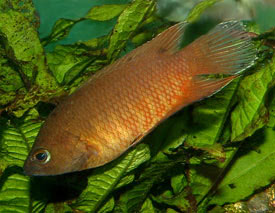
 Magyarul / Hungarian
Magyarul / Hungarian



- Scientific name: Belontia signata
- Synonyms: Macropodus signatus, Polyacanthus signatus
- Common name: Ceylonese combtail, Combtail, Comb-Tailed Paradise Fish, Ceylon fighting fish
- Group: Labyrinth fishes
- Habitat:Asia; Sri Lanka
- Size: 12-13 cm
- Biotope: Found in slow-flowing parts of shallow, clear water mountainstreams with a substrate of sand and small rocks.
- Social behavior: Not recommended for a community aquarium, because males generally aggressive with conspecifics, especially during spawning. Only young fish are to be recommended for the community tank.
- Diet: Omnivorous; in nature they eat mostly invertebrates, in aquarium they accept live and frozen foods and even quality flake foods.
- Breeding: Quite easy
- Tank: Minimum 100 litres
- Population: 2-3 fish for 100 litres
- Decoration: Prefers a tank with heavy vegetation and plenty of hiding places. Use floating plants to dim the lighting.
- Temperature: 23-28 °C
- pH: 6-7.5
- Hardness: 8-15 NK°
- Lifespan: 5-8 years
Description: Belontia signata has 3 known color forms. The most common has reddish body color, and has no spot at the base of the pectoral fin. The second has a reflective, turquoise spot at the base of the pectoral fin, and has some blue, iridescent scales in the lower part of the body (possibly Belontia signata jonklaasi). The third color form has more brownish body with bluish extendnig filaments from the caudal fin, and usually found in lowland habitats.
Sexes are not easily ditinguished when young. The mature males are noticeably larger, have more intense colors, and their dorsal fin is more greatly extended. Ceylonese combtail are biparental bubblenest builders, and easy to breed in soft acidic water. Temperature should be increased above 27 °C. Male will build a hardly noticable nest with very few large bubbles at the surface or under floating plant leaves. Sometimes no bubblenest is present at all. The female lay up to 200 small floating eggs, which will hatch in 24-48 hours. Both parents protect the eggs and the fry. The fry swim freely only after 5-6 days and then immediately eat Artemia and very fine flake food. Parents will eat the fry, so to raise a large number of fry it's recommended to remove the parents after spawning.





















